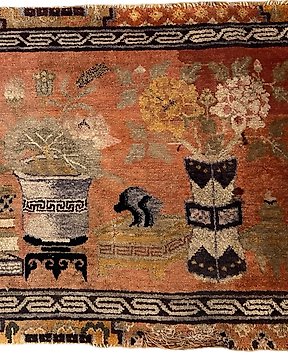
Chinees Baotou Scholar-tapijt - China - Qing Dynastie (1644-1911)
Nr. 81854117

Nr. 81854117

Gorgeous antique Manila shawl made of black silk with peony embroidery in a wide variety of colors, one of the most sought after on the market. As is usual in this type of piece, the basic fabric is silk, and the threads on which the decorations are embroidered are also silk. The bird motifs used add a unique beauty.
The technique used is intricate embroidery, where it is possible to represent floral motifs such as peonies. Before working on the piece, a drawing was made on paper and holes were drilled; Then, the perforated templates were marked with chalk, leaving a mark on the fabric that was framed for processing.
The perimeter of this magnificent piece is completed by creating a fringe, an element inherited from the Arabs, made with silk thread and macramé technique.
The composition begins with a small central peony; from here four large peonies are distributed symmetrically, in various shades of pink, all very saturated. Different flowers, plant elements and birds are scattered around it... The perfection of the coverings, the large size and vivid color of the flowers in the middle make this shawl one of the most valuable shawls.
Origin and history
The origin of Manila shawls dates back to China around 600 AD during the Tang dynasty; Hypothesis supported by the fact that the Chinese were the first to discover silk and embroider with silk threads. The oldest example of this type of embroidery was found in a tomb belonging to the Zhou dynasty (6th century BC).
However, in the 15th century, it received the name "Mantón de Manila" because this was precisely Manila, the capital of the Philippines and the former territory of the Spanish Empire, and the origin of maritime trade routes during the imperial period. Where did these works come from?
Through the eastern routes, it reached Spain, Portugal and America, which were in high demand by high society women. In this way, it became one of the most popular women's accessories in the 18th century. In our country, they achieved the greatest popularity in Andalusia. In the 20th century, the art of embroidery became professionalized and workshops to create these works spread throughout Andalusia. It is currently a symbol of Andalusian culture and tradition, a sign of beauty and sensuality and an excellent element of flamenco and its visual spectacle. Although their use has never disappeared, these pieces are now being “revived” thanks to the figure of influencers and have spread to international catwalks, being transformed into skirts, blouses and even wedding dresses. .
Gorgeous antique Manila shawl made of black silk, embroidered in a wide variety of colours. As is usual in this type of piece, the basic fabric is silk, and the threads with which the decorations are embroidered are also silk.
The technique used is intricate embroidery, where it is possible to represent floral motifs such as peonies. Before working on the piece, a drawing was made on paper and holes were drilled; Then, the perforated templates were marked with chalk, leaving a mark on the fabric that was framed for processing.
The perimeter of this magnificent piece is completed by creating a fringe, an element inherited from the Arabs, made with silk thread and macramé technique.
Zo koop je op Catawiki
1. Ontdek iets bijzonders
2. Plaats het hoogste bod
3. Veilig betalen